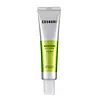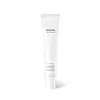What's inside
What's inside
 Key Ingredients
Key Ingredients

 Benefits
Benefits

 Concerns
Concerns

 Ingredients Side-by-side
Ingredients Side-by-side

Water
Skin ConditioningGlycerin
HumectantCyclohexasiloxane
EmollientHydrogenated Polydecene
EmollientPolyglyceryl-3 Methylglucose Distearate
EmulsifyingButylene Glycol
HumectantButyrospermum Parkii Butter
Skin ConditioningNiacinamide
SmoothingPropanediol
SolventCetyl Alcohol
EmollientMacadamia Integrifolia Seed Oil
Skin ConditioningPersea Gratissima Oil
Skin ConditioningPolyglyceryl-2 Stearate
EmulsifyingOryza Sativa Extract
AbsorbentPolyacrylate-13
Behenyl Alcohol
EmollientGlyceryl Stearate
EmollientPolyglyceryl-10 Laurate
Skin Conditioning1,2-Hexanediol
Skin ConditioningDimethicone/Vinyl Dimethicone Crosspolymer
Skin ConditioningPolyglyceryl-10 Myristate
Skin ConditioningSodium Stearoyl Glutamate
CleansingStearyl Alcohol
EmollientCetearyl Alcohol
EmollientHydrogenated Lecithin
EmulsifyingDipropylene Glycol
HumectantHydrogenated Polyisobutene
EmollientHydroxyacetophenone
AntioxidantEclipta Prostrata Leaf Extract
Skin ConditioningLaminaria Japonica Extract
Skin ProtectingPhytosteryl/Isostearyl/Cetyl/Stearyl/Behenyl Dimer Dilinoleate
Skin ConditioningGlyceryl Stearate Se
EmulsifyingAlcohol
AntimicrobialEthylhexylglycerin
Skin ConditioningXanthan Gum
EmulsifyingCholesterol
EmollientEthylhexyl Palmitate
EmollientAdenosine
Skin ConditioningFructooligosaccharides
HumectantSorbitan Isostearate
EmulsifyingDisodium EDTA
Beta-Glucan
Skin ConditioningCeramide NP
Skin ConditioningCentella Asiatica Extract
CleansingFicus Carica Fruit Extract
HumectantHydrolyzed Hyaluronic Acid
HumectantPhellodendron Amurense Bark Extract
Skin ConditioningDextrin
AbsorbentTheobroma Cacao Seed Extract
AntioxidantTocopherol
AntioxidantWater, Glycerin, Cyclohexasiloxane, Hydrogenated Polydecene, Polyglyceryl-3 Methylglucose Distearate, Butylene Glycol, Butyrospermum Parkii Butter, Niacinamide, Propanediol, Cetyl Alcohol, Macadamia Integrifolia Seed Oil, Persea Gratissima Oil, Polyglyceryl-2 Stearate, Oryza Sativa Extract, Polyacrylate-13, Behenyl Alcohol, Glyceryl Stearate, Polyglyceryl-10 Laurate, 1,2-Hexanediol, Dimethicone/Vinyl Dimethicone Crosspolymer, Polyglyceryl-10 Myristate, Sodium Stearoyl Glutamate, Stearyl Alcohol, Cetearyl Alcohol, Hydrogenated Lecithin, Dipropylene Glycol, Hydrogenated Polyisobutene, Hydroxyacetophenone, Eclipta Prostrata Leaf Extract, Laminaria Japonica Extract, Phytosteryl/Isostearyl/Cetyl/Stearyl/Behenyl Dimer Dilinoleate, Glyceryl Stearate Se, Alcohol, Ethylhexylglycerin, Xanthan Gum, Cholesterol, Ethylhexyl Palmitate, Adenosine, Fructooligosaccharides, Sorbitan Isostearate, Disodium EDTA, Beta-Glucan, Ceramide NP, Centella Asiatica Extract, Ficus Carica Fruit Extract, Hydrolyzed Hyaluronic Acid, Phellodendron Amurense Bark Extract, Dextrin, Theobroma Cacao Seed Extract, Tocopherol
Water
Skin ConditioningHydrogenated Poly(C6-14 Olefin)
EmollientGlycerin
HumectantDimethicone
EmollientPropanediol
SolventBis-Diglyceryl Polyacyladipate-2
EmollientCetearyl Alcohol
EmollientNiacinamide
SmoothingPolyglyceryl-3 Methylglucose Distearate
Emulsifying1,2-Hexanediol
Skin ConditioningPanthenol
Skin ConditioningGlyceryl Stearate
EmollientDimethicone/Vinyl Dimethicone Crosspolymer
Skin ConditioningPolyglyceryl-3 Distearate
EmulsifyingCarbomer
Emulsion StabilisingHydrogenated Lecithin
EmulsifyingTromethamine
BufferingTitanium Dioxide
Cosmetic ColorantEthylhexylglycerin
Skin ConditioningAdenosine
Skin ConditioningGlyceryl Stearate Citrate
EmollientChrysanthemum Morifolium Flower Extract
Skin ConditioningLactobacillus
Skin ConditioningLactobacillus/Rice Ferment
Skin ConditioningLactobacillus/Soybean Ferment Extract
Skin ConditioningSaccharomyces/Barley Seed Ferment Filtrate
HumectantSaccharomyces/Potato Extract Ferment Filtrate
HumectantTocopherol
AntioxidantWater, Hydrogenated Poly(C6-14 Olefin), Glycerin, Dimethicone, Propanediol, Bis-Diglyceryl Polyacyladipate-2, Cetearyl Alcohol, Niacinamide, Polyglyceryl-3 Methylglucose Distearate, 1,2-Hexanediol, Panthenol, Glyceryl Stearate, Dimethicone/Vinyl Dimethicone Crosspolymer, Polyglyceryl-3 Distearate, Carbomer, Hydrogenated Lecithin, Tromethamine, Titanium Dioxide, Ethylhexylglycerin, Adenosine, Glyceryl Stearate Citrate, Chrysanthemum Morifolium Flower Extract, Lactobacillus, Lactobacillus/Rice Ferment, Lactobacillus/Soybean Ferment Extract, Saccharomyces/Barley Seed Ferment Filtrate, Saccharomyces/Potato Extract Ferment Filtrate, Tocopherol
 Reviews
Reviews

Ingredients Explained
These ingredients are found in both products.
Ingredients higher up in an ingredient list are typically present in a larger amount.
1,2-Hexanediol is a synthetic liquid and another multi-functional powerhouse.
It is a:
- Humectant, drawing moisture into the skin
- Emollient, helping to soften skin
- Solvent, dispersing and stabilizing formulas
- Preservative booster, enhancing the antimicrobial activity of other preservatives
Adenosine is in every living organism. It is one of four components in nucleic acids that helps store our DNA.
Adenosine has many benefits when used. These benefits include hydrating the skin, smoothing skin, and reducing wrinkles. Once applied, adenosine increases collagen production. It also helps with improving firmness and tissue repair.
Studies have found adenosine may also help with wound healing.
In skincare products, Adenosine is usually derived from yeast.
Learn more about AdenosineCetearyl alcohol is a mixture of two fatty alcohols: cetyl alcohol and stearyl alcohol. It is mainly used as an emulsifier. Emulsifiers help prevent the separation of oils and products. Due to its composition, it can also be used to thicken a product or help create foam.
Cetearyl alcohol is an emollient. Emollients help soothe and hydrate the skin by trapping moisture.
Studies show Cetearyl alcohol is non-toxic and non-irritating. The FDA allows products labeled "alcohol-free" to have fatty alcohols.
This ingredient is usually derived from plant oils such as palm, vegetable, or coconut oils. There is debate on whether this ingredient will cause acne.
Due to the fatty acid base, this ingredient may not be Malassezia folliculitis safe.
Learn more about Cetearyl AlcoholThis ingredient is a silicone used to improve the texture of products and absorb oil. It does not get absorbed into the skin.
Like other silicones, Dimethicone/Vinyl Dimethicone Crosspolymer helps condition the skin by creating a barrier. In this sense, it can act as an emollient and trap moisture in.
This ingredient is a type of elastomer.
Learn more about Dimethicone/Vinyl Dimethicone CrosspolymerEthylhexylglycerin (we can't pronounce this either) is commonly used as a preservative and skin softener. It is derived from glyceryl.
You might see Ethylhexylglycerin often paired with other preservatives such as phenoxyethanol. Ethylhexylglycerin has been found to increase the effectiveness of these other preservatives.
Glycerin is already naturally found in your skin. It helps moisturize and protect your skin.
A study from 2016 found glycerin to be more effective as a humectant than AHAs and hyaluronic acid.
As a humectant, it helps the skin stay hydrated by pulling moisture to your skin. The low molecular weight of glycerin allows it to pull moisture into the deeper layers of your skin.
Hydrated skin improves your skin barrier; Your skin barrier helps protect against irritants and bacteria.
Glycerin has also been found to have antimicrobial and antiviral properties. Due to these properties, glycerin is often used in wound and burn treatments.
In cosmetics, glycerin is usually derived from plants such as soybean or palm. However, it can also be sourced from animals, such as tallow or animal fat.
This ingredient is organic, colorless, odorless, and non-toxic.
Glycerin is the name for this ingredient in American English. British English uses Glycerol/Glycerine.
Learn more about GlycerinGlyceryl Stearate is a mix of glycerin and stearic acid.
It is used to stabilize the mixing of water and oil ingredients. By preventing these ingredients from separating, it can help elongate shelf life. It can also help thicken the product's texture.
As an emollient, it helps soften skin and supports barrier-replenishing ingredients.
In cosmetics, Glyceryl Stearate is often made from vegetable oils or synthetically produced.
This ingredient may not be fungal-acne safe
Fun fact: The human body also creates Glyceryl Stearate naturally.
Learn more about Glyceryl StearateHydrogenated Lecithin is created from the hydrogenation of lecithin (a group of phospholipids). Hydrogenation is a chemical reaction between hydrogen and another element.
This ingredient is an emollient and emulsifier. As an emollient, it helps soften skin by trapping moisture within. As an emulsifier, it prevents oil and water ingredients from separating.
Niacinamide is a multitasking form of vitamin B3 that strengthens the skin barrier, reduces pores and dark spots, regulates oil, and improves signs of aging.
And the best part? It's gentle and well-tolerated by most skin types, including sensitive and reactive skin.
You might have heard of "niacin flush", or the reddening of skin that causes itchiness. Niacinamide has not been found to cause this.
In very rare cases, some individuals may not be able to tolerate niacinamide at all or experience an allergic reaction to it.
If you are experiencing flaking, irritation, and dryness with this ingredient, be sure to double check all your products as this ingredient can be found in all categories of skincare.
When incorporating niacinamide into your routine, look out for concentration amounts. Typically, 5% niacinamide provides benefits such as fading dark spots. However, if you have sensitive skin, it is better to begin with a smaller concentration.
When you apply niacinamide to your skin, your body converts it into nicotinamide adenine dinucleotide (NAD). NAD is an essential coenzyme that is already found in your cells as "fuel" and powers countless biological processes.
In your skin, NAD helps repair cell damage, produce new healthy cells, support collagen production, strengthen the skin barrier, and fight environmental stressors (like UV and pollution).
Our natural NAD levels start to decline with age, leading to slower skin repair, visible aging, and a weaker skin barrier. By providing your skin niacinamide, you're recharging your skin's NAD levels. This leads to stronger, healthier, and younger looking skin.
Another name for vitamin B3 is nicotinamide. This vitamin is water-soluble and our bodies don't store it. We obtain Vitamin B3 from either food or skincare. Meat, fish, wheat, yeast, and leafy greens contain vitamin B3.
The type of niacinamide used in skincare is synthetically created.
Learn more about NiacinamidePolyglyceryl-3 Methylglucose Distearate is created from the diester of stearic acid and the condensation product of methylglucose and Polyglycerin-3.
As an emulsifier, it is used to bind ingredients together. Many ingredients, such as oils and water, separate naturally. Emulsifiers prevent them from separating to ensure even consistency in texture.
One of the manufacturer for this ingredient states it is vegetable-based. It is also claimed to be stable at both high and low temperatures.
This ingredient may not be safe for fungal acne. We recommend speaking with a professional if you have any concerns.
Learn more about Polyglyceryl-3 Methylglucose DistearatePropanediol is an all-star ingredient. It softens, hydrates, and smooths the skin.
It’s often used to:
Propanediol is not likely to cause sensitivity and considered safe to use. It is derived from corn or petroleum with a clear color and no scent.
Learn more about PropanediolTocopherol (also known as Vitamin E) is a common antioxidant used to help protect the skin from free-radicals and strengthen the skin barrier. It's also fat soluble - this means our skin is great at absorbing it.
Vitamin E also helps keep your natural skin lipids healthy. Your lipid skin barrier naturally consists of lipids, ceramides, and fatty acids. Vitamin E offers extra protection for your skin’s lipid barrier, keeping your skin healthy and nourished.
Another benefit is a bit of UV protection. Vitamin E helps reduce the damage caused by UVB rays. (It should not replace your sunscreen). Combining it with Vitamin C can decrease sunburned cells and hyperpigmentation after UV exposure.
You might have noticed Vitamin E + C often paired together. This is because it is great at stabilizing Vitamin C. Using the two together helps increase the effectiveness of both ingredients.
There are often claims that Vitamin E can reduce/prevent scarring, but these claims haven't been confirmed by scientific research.
Learn more about TocopherolWater. It's the most common cosmetic ingredient of all. You'll usually see it at the top of ingredient lists, meaning that it makes up the largest part of the product.
So why is it so popular? Water most often acts as a solvent - this means that it helps dissolve other ingredients into the formulation.
You'll also recognize water as that liquid we all need to stay alive. If you see this, drink a glass of water. Stay hydrated!
Learn more about Water